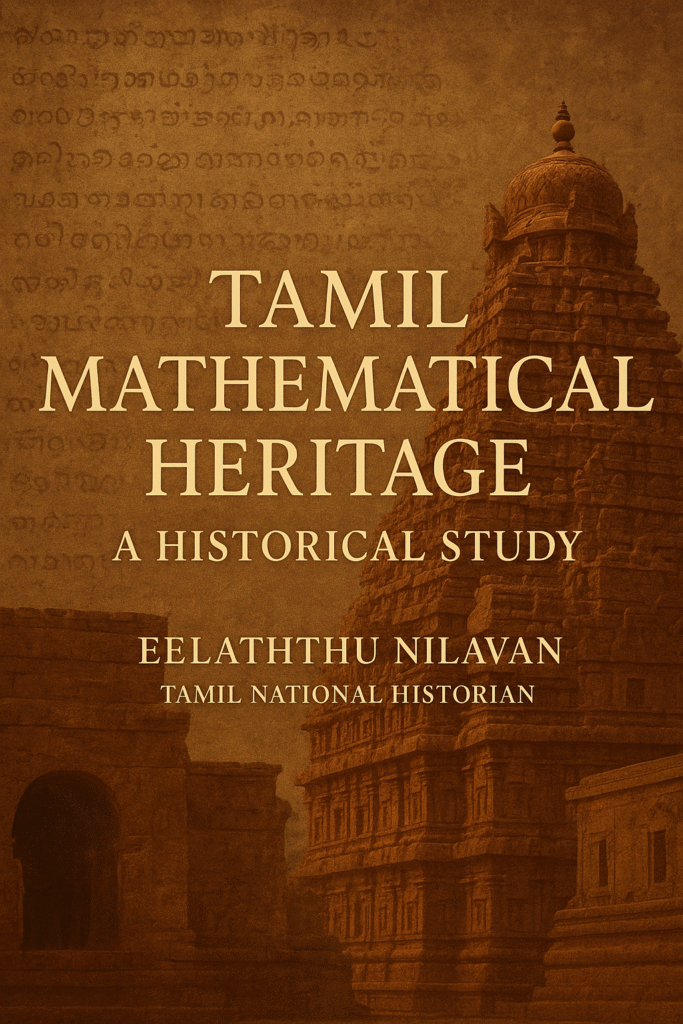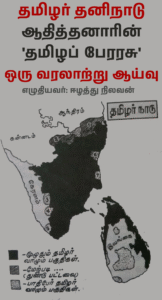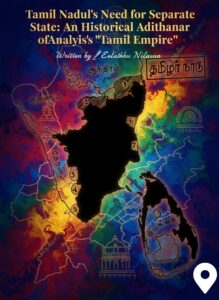✧. Introduction
Tamil history encompasses not only politics, wars, trade, and literature, but also a rich cultural heritage. It also encompasses science, mathematics, astronomy, medicine, sculpture, and architecture. Among these, mathematical knowledge holds a special place.
Contrary to claims that Tamils lacked numerical knowledge, evidence from inscriptions, Sangam literature, and Chola records proves that Tamils had a clear understanding of both very large numbers (infinity) and extremely small fractions.
This paper examines the concept of “Ennum Varampu Aariya” from Paripadal (meaning “numbers without end”), which refers to infinity, and the smallest fractional measurement recorded in the Thanjavur Periyakovil inscription: 1/54,428,800,000.

✦. Paripadal – The Expression of Infinity
Paripadal (verses 35–45) lists numbers sequentially:
• One, Two, Three … Ten, Hundred, Thousand, Ten Thousand, Hundred Thousand
It concludes with the line:
“Aambal innaiththu ennum varampu aariya”
Meaning: Numbers without limit → Infinity.
This proves that the Tamil concept of infinity predates similar ideas in Greek and European mathematics.
✦. Thanjavur Periyakovil Inscriptions – The Smallest Numbers
(a) Inscription Text
During Raja Raja Chola’s reign, inscriptions recorded land donations with incredible precision:
“Palliyung kanimuttruuttum utpada alandhapadi nilam …”
Units mentioned include: Ma, Kani, Muththirigai.
(b) Fractional Units and Decimal Values
Tamil Unit Fraction Decimal Value Mukkal3/40.75Arai1/20.5Kaal1/40.25Veesam1/160.0625Ma1/200.05Kani1/800.0125Muththirigai1/3200.003125
(c) The Smallest Number
The inscription records an extraordinary fractional unit:
“1 / 54,428,800,000”
In Tamil: “Aindhaayirathu naanooru naalpathirandu kodiye enbaththu ilatchaththil oru pangu”.
Such mathematical precision is rare in any other civilization of that era.
✦. Chola Records and Precision Mathematics
Chola inscriptions reveal details such as:
• Land measurements
• Tax calculations
• Temple endowments
Units included foot, half-foot, quarter-foot, angulam (inch), half-angulam, quarter-angulam, and muththirigai.
This reflects the accuracy of Tamil surveying, taxation, and mathematical skills.
✦. Comparison with Modern Mathematics
Modern Concept Tamil Equivalent Infinity (∞)“Ennum Varampu Aariya” Fractions Mukkal, Muththirigai etc.Smallest Unit1 / 54,428,800,000
Tamil mathematics combined literature, philosophy, and science into a unique intellectual tradition.
✦. Necessity of Such Precision
• Taxation: Land tax for temples required an accurate calculation.
• Donations: Land grants had to be recorded with precise boundaries.
• Future Proof: Ensured later generations could verify Tamil mathematical methods.
✦. Continuity of Tamil Scientific Knowledge
• Sangam Literature → Paripadal: Infinity concept
• Perunkappiyam → Silappathikaram: Measurement of time
• Chola Inscriptions: Fractional precision
• Modern Tamil Knowledge: Infinity and decimals
This demonstrates the continuity and evolution of Tamil scientific tradition.
✦. Conclusion:
The accusation that Tamils had no numbers, only words, is entirely false. Evidence shows:
• Largest Number: Paripadal → “Ennum Varampu Aariya” (Infinity)
• Smallest Number: Thanjavur inscription → 1 / 54,428,800,000
Thus, Tamil mathematics was world-class, precise, and philosophically advanced, reflecting the uniqueness of Tamil civilization’s scientific heritage.

Author: Eelaththu Nilavan
Tamil National Historian
“Dedicated to introducing ancient Tamil knowledge and mathematical heritage to the world”



